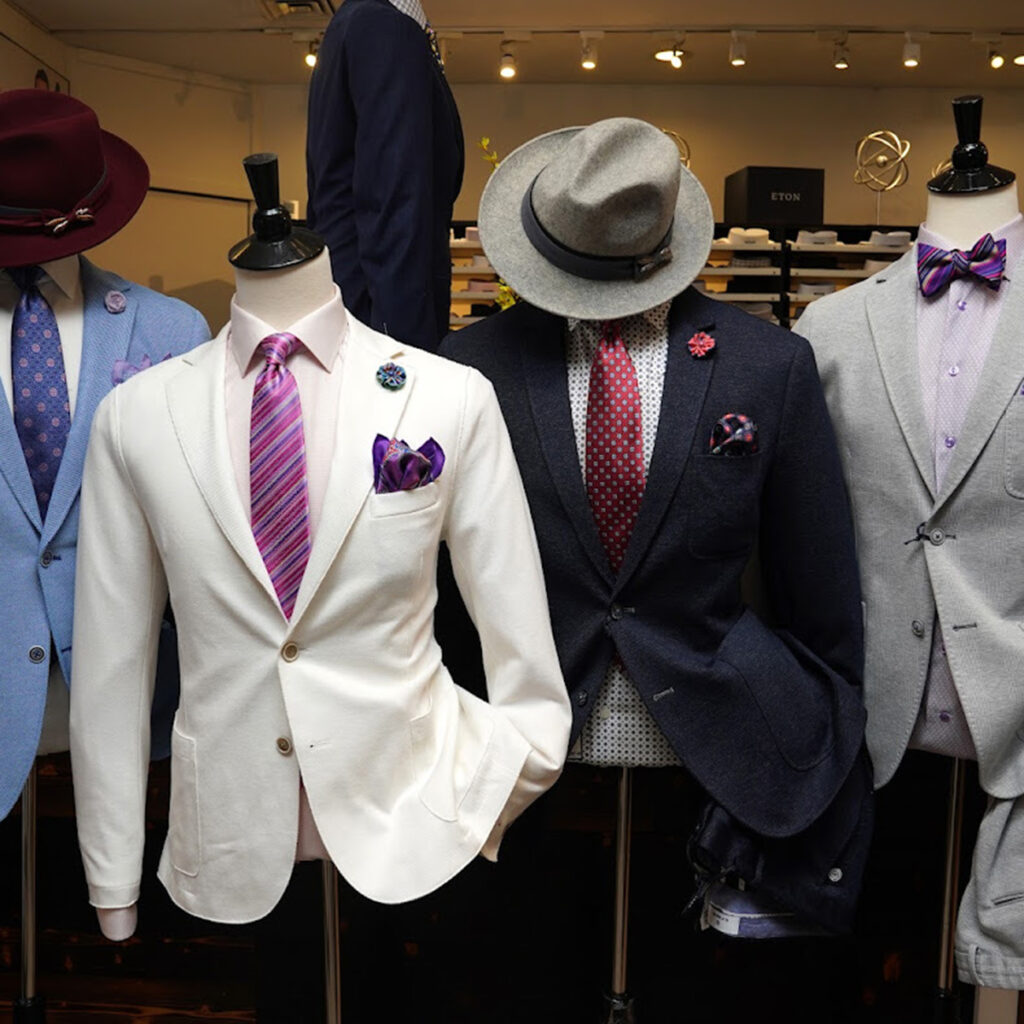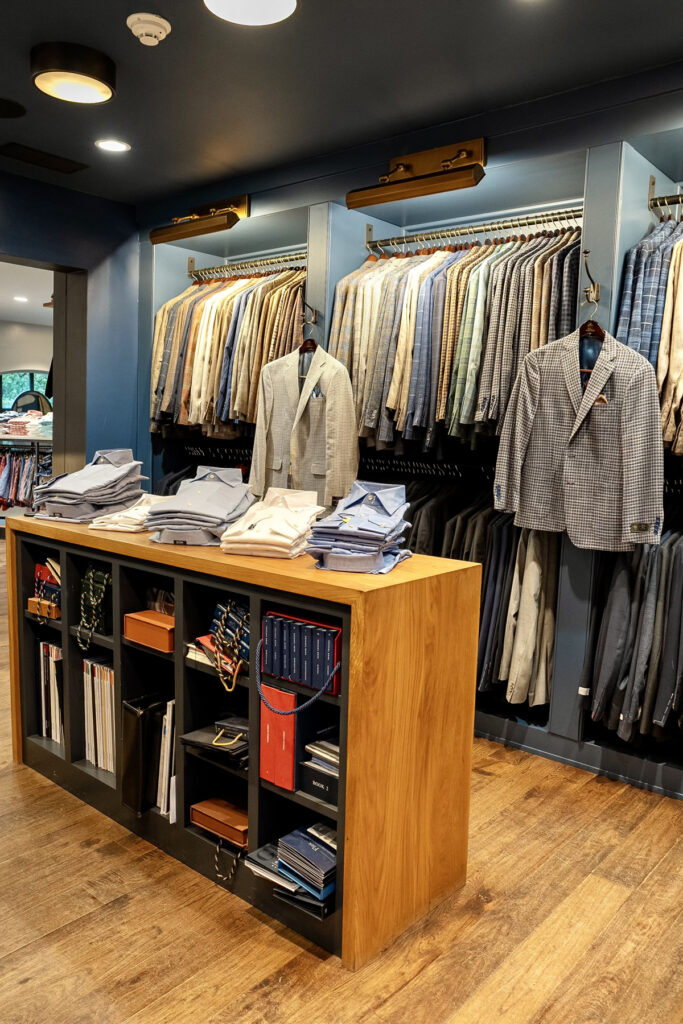SPONSORED: HOW BEST TO SELL SUITS? CLOTHING EXPERTS SHARE SECRETS

Clients agree that Peerless makes fabulous tailored clothing—beautifully designed, cut from the finest fabrics, priced to sell with margin. But since it’s you, the retailers, who ultimately make the sale, MR magazine rounded up a few expert merchants to reveal some selling tips. Try the ones that resonate for you, and share with your team on the selling floor!
Chuck Hellman, Hellman’s Clothiers, Cincinnati, Ohio
- Show the product fully dressed: a suit without accessories is a day without sunshine.
- Speak about WHY customers should buy the product from your store, e.g. Free alterations for life; Merchandise guaranteed for life; Styling help always available, even beyond brick & mortar locations.
- Show new looks on social media.
- Send out pics of merchandise to customers and prospects.
- Keep current measurements in CRM system to prepare for their next purchase.
- Explain to customers which items are NOS (never out of stock).
- Have a tailor present to facilitate any at-once needs to secure the purchase.
- Make sure customers understand turnaround on alterations (we do same day!)
- Be honest: don’t sell anything that doesn’t fit properly.
- Don’t assume by initial appearance that the customer does not want to be upgraded or updated.
- Don’t show a suit or sportcoat by itself! Enhance the initial presentation.
- Don’t assume the customer is okay with the price. Be upfront with them and build trust.
- Don’t make the sale unless it’s a great fit.

Joe Orlando, Joseph Orlando, Pittsburgh, Pa.
- Look the part! Sellers should alternate between classic and fashion, between tie and no tie.
- Get the suit on him! Young guys love to look at themselves in the mirror; they can stare at themselves far longer than any 50-year-old. So get the suit on him as soon as possible.
- Explain where the suit was made, what fabrics were used, and how the tailor can customize it so it reflects his personal style.
- Most often, young guys have already done some research. Don’t go crazy with details but be prepared to answer questions. A typical question: the difference between half canvas and full canvas.
- Establish trust: Do what you say you’ll do, never sell something that doesn’t flatter the client, under-promise and over-deliver.
Todd Fliginger, MP3, Minneapolis, Minn.
- Teach your clients what’s trending; let them experience all that’s new and available to them.
- Observe and listen to their needs so you can effectively come up with a plan, working together for the perfect next step.
- Deliver the most amazing customer service experience possible to ensure that the shopping process is flawless and memorable.
- Desire is created between seller and client so you both want the experience to intensify each time a new step is taken.
Robby Miller, Miller Brothers, Atlanta, Ga.
- You can’t sell from an empty wagon.
- Count and fill on basics: grey suit, navy suit, tuxedo, blazer.
- Always have a full size-run on basics: 38R-48R, 40L-48L, 38S-44S, plus an occasional 50 and 52 regular and long.

Dan Kocks, MS McLellan, Knoxville, Tenn.
- Show clothing on forms, mannequins, in windows, with and without a tie
- Show suits and sportscoats with knit tees and open collar sport shirts to promote versatility; young customers will be more prone to try a suit if shown without the shirt and tie.
- Don’t follow customers around the store as they shop!
Elliot Logan, Logans, Lexington, Ky.
- Presentation is paramount; there’s no second chance to make a first impression.
- Offer a broad selection of brands, models, colors, and fabrics.
- Have sellers available to assist.
- Create an unpretentious atmosphere, but show merchandise with enthusiasm and confidence.
- Talk it up but don’t over-talk it; don’t make it complicated.
- When the customer comes out of the fitting room, have complementary shirts and ties right there. (Don’t ask if they want to see some shirts and ties: they will instinctively say they don’t need any…)
- Never push a sale; if it’s not right or the customer isn’t sure, let it go.
Chris Lambert, Christopher James, Fort Wayne, Ind.
- Hire good people who are not just good sellers but who enjoy building relationships.
- I believe in sales commissions: I’ve been in this business for 40 years and a commission structure is not just about the money. Our sellers understand that they’re working for the goodwill of the store: they help each other out while respecting each other’s territory. Plus, a commission structure makes them feel more responsible for their business and gives them a sense of ownership. Sellers who don’t support this theory rarely stick around too long anyway.
Wally Naymon, Kilgore Trout, Cleveland, Ohio
Hire associates who believe in “better clothing” – and who can explain the difference.
For information about how Peerless can make a difference in your tailored clothing sales, contact Michael Holdstein at michaelh@peerless-clothing.com.









Great points of wisdom & knowledge of the menswear industry of selling suits.
Passion, enthusiasm and questions…
Those have been my success keys over the last 46 years.
Passion and enthusiasm are contagious and questions open up buying motives.
… and don’t be a Sammy Slammy!